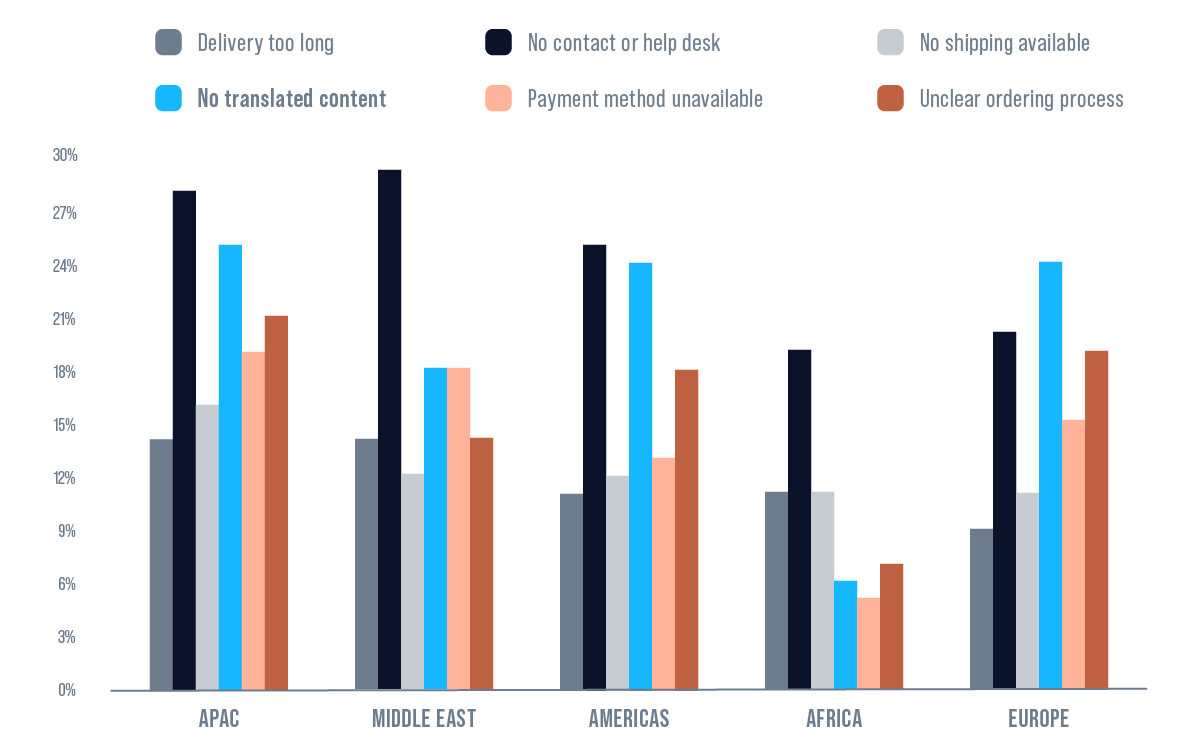
Blog
Contents
Machine Translation Report
What is the optimal MT Engine for you? Find out in the latest MT Report by Memsource.

The customer journey doesn’t stop after a sale is made. Some companies pump majority of their resources into new business but are unaware that attracting new prospects is up to 25% more expensive than retaining current customers.
Excellent customer support is key to customer retention, but if your company is targeting global consumers, you need to have a strategy in place which supports your clients and customers, in their preferred language. According to a CSA Research report, 75% of B2B and B2C buyers surveyed agreed they would be more likely to repurchase from a brand if the after-sales care is in their native language. For European markets, Nimdzi found that having “no translated content” is the main customer service concern, and the second biggest concern for both the APAC and the American markets.

Customer service concerns by region
Here’s a checklist for launching a multilingual customer service strategy for your business to keep your customers coming back for more:
Know your customers’ expectations
You need to know your markets and your customers well in order to meet their expectations and properly address their needs. Do your due diligence. Look at your regions and decide which languages you need to support. You may find that you can’t translate everything. Identify high-priority markets with the greatest ROI potential and start there. You’ll also need to go beyond language. Research communication styles for your different audiences and find out which channels they use for customer support.
Establish cross-cultural best practices
Now you need to establish some ground-rules. Prepare communication guidelines so that your team and translators have a reference for how to communicate in different cultural contexts. Document language and cultural norms and establish a specific guideline. For example, your service agents or chabot may greet users by their first name in the US market, but this is considered disrespectful in Japan. For a Japanese audience, it would be more appropriate to address customers by their last name followed by the suffix -san. You should also make sure to use simple, concise language to avoid miscommunication.
Make sure the product is localized properly
If you’re receiving a ton of support requests in a particular language, there may be a problem with your product localization. You need to get the product localization right first before spending resources on translating and localizing your support content.
Localize your help center
Today’s consumers are smarter than ever. 81% of customers will search for the information they need before contacting a support agent. Therefore, an excellent knowledge base is an essential component of a successful customer experience strategy. Making your help center documentation available in multiple languages will enable your customers to serve themselves, freeing up time for your support team to tend to more dire technical issues.
Start with high-priority content. For low priority pages, you can test out raw machine translation. Consider adding a label indicating as such so readers know what to expect and, if possible, add the possibility to rate the translation. This will help you determine whether more resources, such as machine translation post-editing, are needed for that piece of content. You can get valuable feedback and data from your users to help you focus your resources where they are needed most.
PRO TIP: Consider incorporating visuals into your documentation. They will help with clarity, context, and support the content, regardless of which language it’s in.
Make your chatbot multilingual
Chatbots are another way customers can find resources and help themselves. If you’re already using a chatbot on your website, you should consider localizing for your key markets (if it is beneficial for that audience). You need to go beyond simple translations. Localization is key here. Brands often try to express their personality through their chatbots, going as far as adding emojis and gifs. Try keep the language simple, avoid slang and idioms, and make sure the images are culturally appropriate for all audiences. This will help you avoid awkward translations and cultural faux pas.
PRO TIP: Build your customer support with localization in mind. It is easier to fix localization issues in the production stage, so try to implement localization into your customer support strategy as early as possible.
Use a translation management system
A translation management system (TMS) allows you to manage, automate, and track your localization workflow - all in one centralized platform. Most TMSs have a variety of integrations that can connect directly to your customer service software and, with the right set up, can completely automate your help center localization. They also enable you to leverage technologies such as translation memories and machine translation, which help reduce costs and get your content translated quicker. Here are some tips if you need help looking for the best translation software for your customer support department.
Track your efforts
Don’t make decisions based on assumptions. Consolidate your data from your customer service software, your translation management system, Google Analytics, and other platforms in your tech stack to get a clear picture of how your multilingual support strategy is performing. You’ll be able to see how your technical documentation performs across your different languages, identify areas that need more attention, and calculate localization ROI.
Hire wisely
Employ multilingual service agents that will be able to communicate with consumers in their native languages. While this is not essential, there are added benefits for the localization process. They can help review translations and even potentially translate when your professional translators are not available. But remember, just because someone speaks a language doesn’t mean they are a translator. Sure, they can help, but don’t rely on them too much. Never underestimate the importance of having professional translators.
Conclusion
Accommodating your global customers is a worthwhile investment. With a strong support strategy in place which is tailored to meet the needs of your multilingual audiences, you’ll increase customer retention and keep your users happy.



